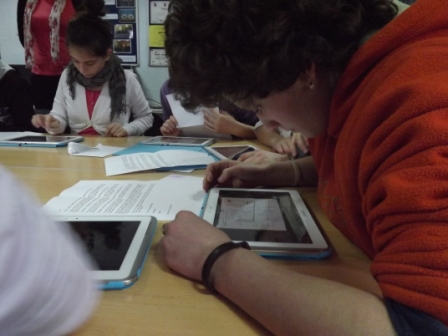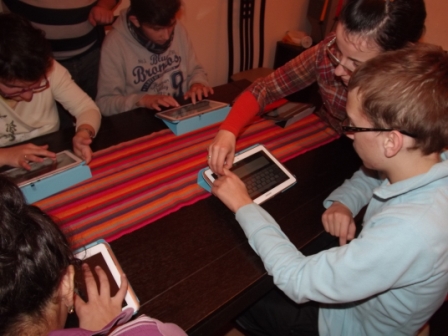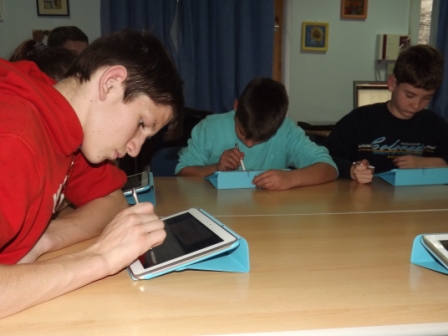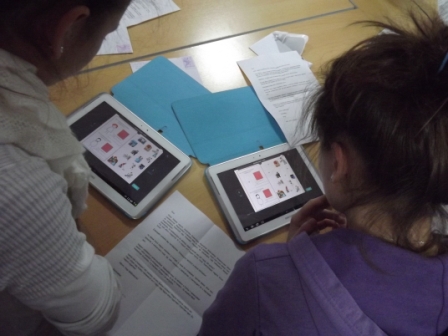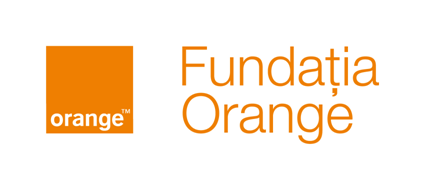Project goals
Our project’s main objective is to create a large (200) set of learning scenarios for various school subjects which require tablet PC usage during the lessons. The scenarios are designed to suit the specific needs of hearing impaired children enrolled in special schools in Romania.
Our project’s main goal is to nurture a new generation of deaf and hard-of-hearing individuals so they can profit from technology to overcome the social impediments caused by their disability. These individuals will use a tablet or other mobile device to communicate with their deaf peers through sign language, with the hearing world through written language, and to find their way or seek answers to everyday problems through technology.
The first step of the project will be the creation of a large set of tablet-PC based learning scenarios for most of the subjects taught in 5th through 8th grade.
Every class should have at least two classes weekly where tablet PCs are used. Taking account of the number of the weeks in a school year, we plan to make 180 learning scenarios. These scenarios consist of a lesson plan which includes individual or group activities using the tablets. The use of the tablets is primarily based on virtual worksheets, which require the design of special software. This will be done by Evoline, one of the biggest software developement firms in Transylvania. The scenarios also include instructions for the lesson plan and virtual worksheets for the teachers on how to use them. With these instructions, any teacher should be able to use these learning scenarios. The scenarios are based on the current curriculum, which can be modified in order to facilitate more interactivity. The scenarios will be done in both Romanian and Hungarian.
The second step will be the trial use of the scenarios using four classes (28 children) in our school.
During this testing period, the scenarios are used, then analyzed and changed if necessary. The objective is to make sure that all learning scenarios are working, that they can be adapted to the individual needs of the children, and can be used with most Hearing Impaired children or children with special educational needs.
The third step is to scale up the results countrywide.
Through this website, information will be posted about the project and all the learning scenarios will be available from there. A small group of teachers will go around the country and demonstrate the scenarios to each school for the Deaf. A short workshop will be organized in our school for teachers from other schools who are interested in their use. Two sets of ten tablet PCs each will be offered to the most interested schools. Long-term, free support will be offered in the years after the project is finalized for schools who want to use the learning scenarios. Evaluation of the level of interest will be made at the end of the project as described below.
Why we do this?
The development of IT resources opened new opportunities for Deaf individuals and Deaf communities throughout the world. Since severe hearing impairment is a low-incidence disability, Deaf people used to be very isolated and restricted in their use of sign language before the appearance of mobile or internet-based. communication. Also, the possibility of working from home and using written language for communication with co-workers raised new possibilities for Deaf people in the job market.
Video blogs using sign language uploaded to YouTube allowed Deaf communities to share ideas to an extent they had never experienced before. SMS messages and, later, video calls via mobile phones mean the same for the Deaf community as the invention of the telephone for hearing people.
However, education systems, especially in countries like Romania, do not keep pace with the development of the IT sector. Deaf children are not taught properly to use the new resources, hence they will not be able to benefit properly from these new possibilities. Schools have computer rooms, but they are mostly used for one hour per week in IT class. In daily usage, pencil and paper are the only resources used. If IT is used in the teaching of a different subject, it is only for one-way communication through the means of a presentation or an educational video. For children who, because of their impairment, need a lot of specially designed visual aids and educational materials that don’t just show them something, but get them involved, the current usage of IT resources in special schools are very far from sufficient. In order for Hearing Impaired individuals to grow to fully use technology in their process of integration into the hearing world, they need to be interactive users of this technology at as young an age as possible. This means they need an education where the interaction with the teacher is not just based on pencil and paper, chalk and blackboard, but on modern resources.
Impact
We hope to create a new pattern of lessons with these leaning scenarios. The teachers involved in the project, and the ones who will get involved to some extent, will hopefully realize how important it is to teach children early on the proper use of technology, and they will start, or continue incorporating, these learning scenarios in their everyday teaching. This way, future generations of hearing impaired children will benefit. As tablet PCs and other mobile devices are used more and more in everyday life, the need to include them in every school would grow in the incoming years. An already developed model of classroom usage will be very welcome, and can serve as the basis for further lesson plan development as Hearing Impaired people come to rely more and more on technological aids. The children involved in our project will spread their knowledge of technology use throughout their communities, and their social status inside and outside their communities will be much greater due to their familiarity with ICT resources.




